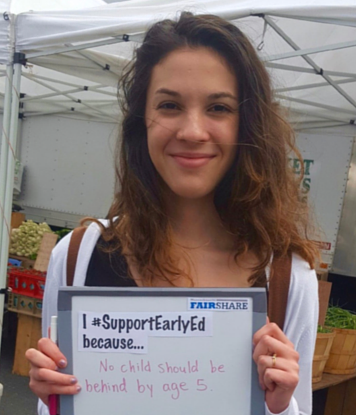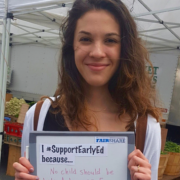
“We thought we were doing everything right,” said Jenny, a young mom and Fair Share supporter. “We thought we were so ahead of things, we had even started a college fund, but … no one told us what we needed was a child care savings fund!”
While young parents like Jenny try to prepare for parenthood, the challenges of arranging and paying for trustworthy child care (which averages nearly a fifth of household income) poses an extra challenge.
According to the last U.S. census, 21,005,852 children in the country are 5 years and younger—approximately 60% of which are enrolled in some sort of early education program. For many others, it’s not that they don’t want to enroll, it’s just too expensive.
For single parent families and the 46% of two-parent families where both parents work full-time, child care is a must. But soaring costs have put it beyond reach for too many. Fair Share, a national grassroots advocacy organization recent surveyed our members to learn about their experience navigating child care – more than ¾ listed affordability as the chief concern.
Many parents face the tricky decision whether to stay at home or return to work after having a baby. Some have the option of paid parental leave, but under federal law, an employee is only granted 12 weeks of unpaid leave, which isn’t affordable to many new parents. One Fair Share member who runs her own small law firm described how she set up a pack-n-play in her office and brought her son to work when he was just 3 weeks old.
For the parents that want to stay home longer with their children, it can be a significant burden even in households with more than one income. One parent in our survey reports that even scaling back to part-time employment is “unfeasible,” stating, “We have to be a two income household, and suspect many are in the same boat.”
Staying home for long periods shouldn’t jeopardize future job prospects and retirement benefits for young parents – but it often does. This is just another frustrating example of how the job market and public programs haven’t kept pace with the evolving nature of being a parent in America.
One father notes that, “Many parents, myself included, want our children to have rich peer relationships—we want our children to interact with other kids, learn how to socialize, and make friends.” For this reason, many choose professional child care centers or qualified in-home family child care.
68% of our survey participants report enrolling their child in a child care center. But all the advantages of center-based care come at a steep price. In the U.S., infant care costs an average of $11,666 per year and preschool-aged care costs about $8,000 per year. In my home state, Massachusetts, it costs as much as $17,000 on average for infant care making it unattainable for many families.
In-home or family child care is often somewhat more affordable, but transportation can be issue, and finding a location that has availability and also an opening can be very difficult.
Parents face the challenge of “finding a place that is of good quality and also affordable,” claiming such centers are “extremely hard to come by”. Survey respondents expressed their frustration at the high cost of preschool and child care, arguing that “It costs as much as our mortgage” and “Most of the places I would want to send my children I cannot afford”.
For this reason, some reported a kind of mash-up of child care, where parents would stay home some days, lean on friends or family to cover other days, and fill in the rest with professional care.
As the reality of child care has changed, so must our policies.
There are a smattering of public programs that help families with child care. Some 1.4 million children receive a child care assistance voucher through the Child Care Development Block Grant program, and another 1 million children are served by Head Start.
One member reported that receiving the voucher was “like winning the lottery” in the difference it made for her family.
Unfortunately, the “current funding level for the Child Care and Development Block Grant provides assistance to only one out of 10 eligible children”. Likewise Head Start has to turn away most eligible families.
Not only are there long waitlists, but parents frequently find themselves earning “too much for vouchers, but not enough to afford [preschool] all the time.”
It’s time for a system that works for parents and teachers
We can cap child care costs: The Economic Policy Institute reports states that “capping child care at 10 percent of family income could boost GDP by as much as $210 billion thanks to an increase in parents’ labor force participation.” Massachusetts Rep. Katherine Clark recently proposed the 21st Century Child Care Investment Act, which would provide tax credits keeping expenses at 10%, improve quality, and increase educator salary.
Stabilizing the child care workforce is also a key to this system. High-turnover among early educators is a huge issue across the landscape, and significantly undermines the kind of quality early education that will help students start kindergarten ready.
Parents need to speak up about the growing child care problem in order to achieve real progress. Until the United States makes necessary changes to its child care system, parents are left to haphazardly piece together parental, informal, and professional care plans just to get by.



The views and opinions expressed in this post are those of the author(s) and do not necessarily reflect those of MomsRising.org.
MomsRising.org strongly encourages our readers to post comments in response to blog posts. We value diversity of opinions and perspectives. Our goals for this space are to be educational, thought-provoking, and respectful. So we actively moderate comments and we reserve the right to edit or remove comments that undermine these goals. Thanks!